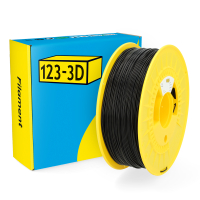Heatbreak
The heatbreak is part of the extruder and ensures that the heater block transfers less heat to the cold end. As a result, the filament only melts at the hot end and the chance of a clogged nozzle is reduced.
Heated bed
A heated bed is a heated
print bed whose temperature can be regulated. This prevents warping of the print. Thanks to a heated bed, the different layers of the 3D print adhere better, which benefits the quality of the 3D prints.
HIPS
HIPS filament is a food-safe and water-resistant filament type that is soluble in d-limonene. As a result, it is often used as a support material. HIPS stands for High Impact Polystyrene, has a high print temperature and is easy to paint and process. Curious about the other properties? Read more about HIPS filament
here.
Hobbed bolt
The
hobbed bolt, also known as 'knurled bolt' or 'driving shaft', is an essential part of the extruder. This bolt is responsible for an even filament supply to the hot end and is equipped with sharp teeth for extra grip during this process.
Hot end
The hot end is a part of the extruder that can become hot, causing the filament to melt. Because each filament has a different heat resistance, it is good to check the settings of the hot end beforehand.














